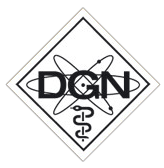
Abstracts der 58. DGN-Jahrestagung 2020
| Medizinische Physik I Virtuelle Posterausstellung |
|
| P22 Emission time optimisation for Ga-68-PSMA with a digital PET/CT – a phantom study P. Fragoso Costa1, F. Süßelbeck1, A. Bramer1, M. Conti2, M. Weber1, D. Kersting1, W. P. Fendler1, K. Herrmann1, W. Jentzen1 1Universtitätsklinikum Essen, Nuklearmedizin, Essen; 2Siemens Medical Solutions, Knoxville, USA | |
|
Ziel/Aim: The potential for reducing the total acquisition time is particularly valuable for prostate cancer patients undergoing Ga-68-PSMA PET/CT examinations enhancing patient comfort, image quality, and throughput. The aim of this study is to optimise the acquisition time in Ga-68-PSMA examinations on a digital Biograph Vision PET/CT using an abdominal tumour phantom.Methodik/Methods: The phantom consists of 6 spheres with inner diameters of 6.5 to 28.0 mm. The phantom was filled with sphere and background activity concentrations (ACs) that were derived from clinical data. Phantom data were acquired in list mode with a duration of 10 min. Different image reconstructions with varying iterations and Gaussian filters were performed, including emission data between 30 and 300 s in 30-s increments. A reference image was reconstructed with 10 min emission time. Two figures of merit (FoMs) were calculated. The detectability was assessed using the contrast-to-noise ratio (CNR); a CNR equal or larger than 8 was considered to be sufficiently visible. Quantification was assessed using the maximum AC (AC-max). The percentage AC-max deviations were calculated between the images at different emission times and the reference image; a percentage deviation range of ±20% was considered acceptable.Ergebnisse/Results: Based on the clinical data, a signal-to-background ratio of 20:1 and a sphere AC of 20 kBq/mL was selected. All spheres but the smallest one were detected in all reconstruction algorithm types and emission times. The following FoMs are referring to the smallest sphere. The optimised emission time was 60 s using OSEM+TOF or OSEM+TOF+PSF (4 iterations, 4 mm Gauss and 3.3x3.3x3.0 mm3voxel size). The FoMs at 60 s were CNROSEM+TOF=15 and CNROSEM+TOF+PSF=24; AC-max deviations were below 20%Schlussfolgerungen/Conclusions: In our phantom study, acquisition time on a digital PET/CT can be reduced by a factor of 2-3, while maintaining lesion detectability similar to our standard clinical protocol. Impact of reduced acquisition time on patient comfort, image quality/pelvic urine background, and throughput will be assessed in future clinical studies. | |


